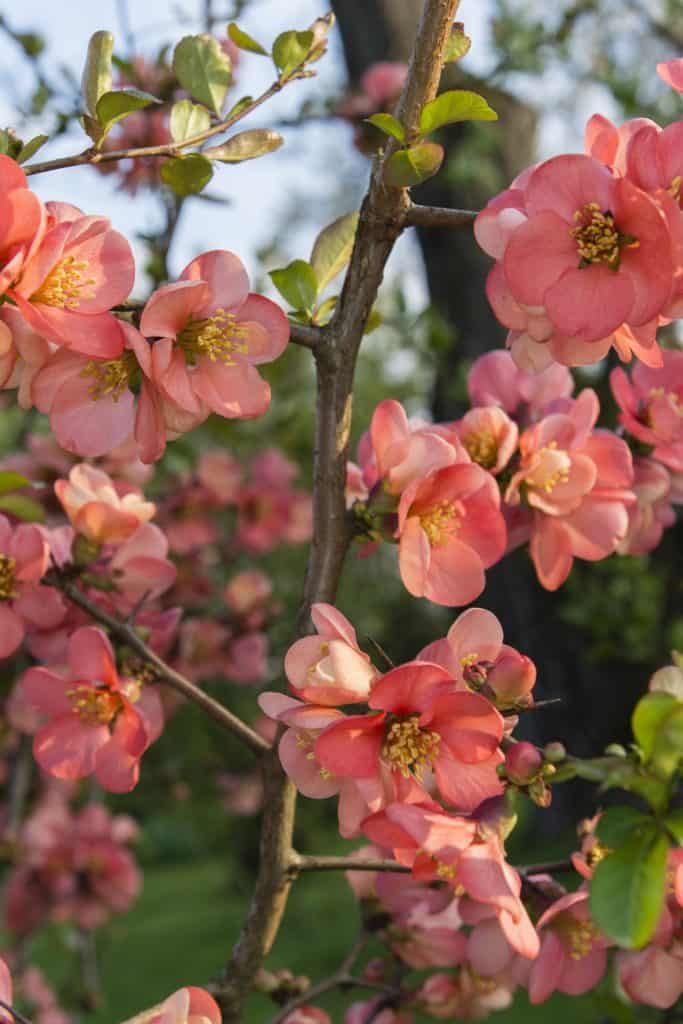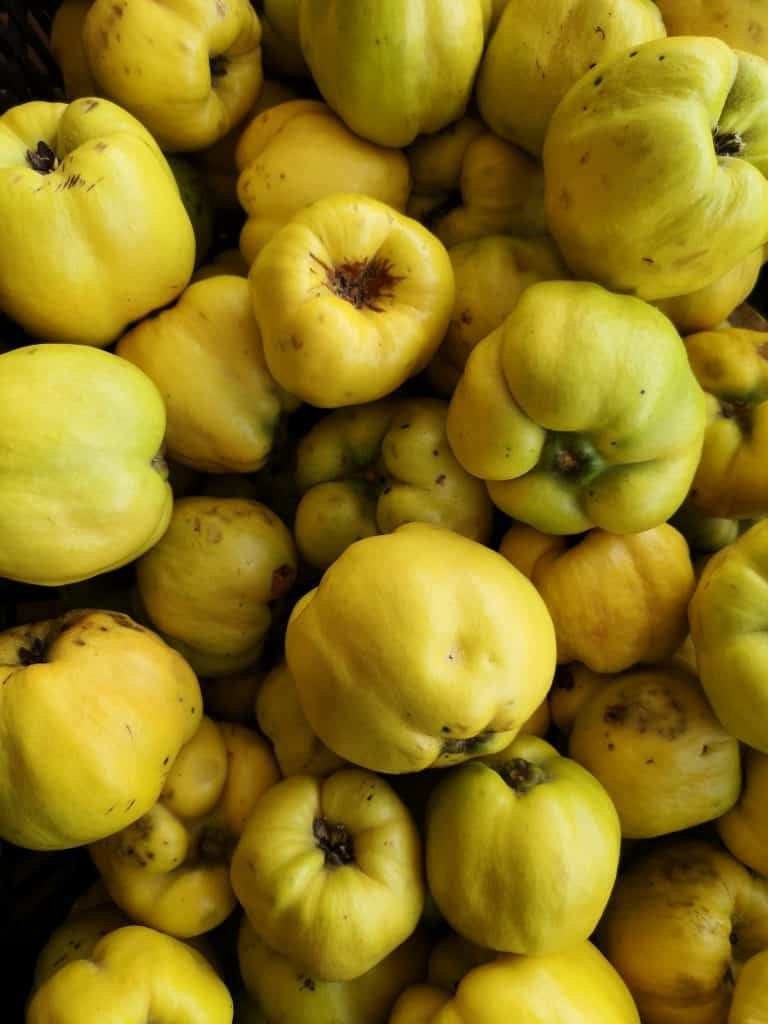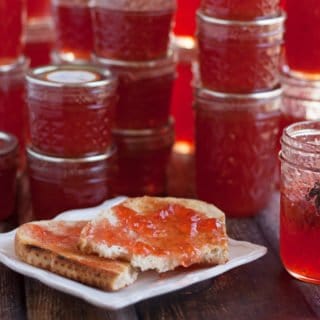This is the only quince jelly recipe you’ll ever need. The rose-colored spread is scented with a hint of lemon zest and a hearty dose of vanilla bean. It’s the perfect way to use up an abundant quince harvest.

This post may contain affiliate links. As an Amazon Associate, I earn from qualifying purchases. See my Affiliate Disclosure.
Quince Jelly Is a Rare Treat Made from Found Treasure
I get a real kick out of “finding” food and turning it into something delicious like quince jelly. At my first sleep-away camp at age 7, my buddies and I plucked huckleberries from vines alongside a hiking trail. We proudly presented our buckets of the tiny tart-sweet berries to the hippy camp cooks (this was a self-sufficient organic farm camp in Northern California in the 1970s) and they turned them into moist cakes topped with a crunchy sugar glaze. We were SO proud when they served them to the entire camp for dessert that night.
I’ve fished for Dungeness crab off a sailboat in Washington’s San Juan Islands and in California’s Tomales Bay, fished for blue crabs in tidal rivers in New England, collected greens and herbs while hiking, and hunted mushrooms in the forest.

My neighborhood is a veritable fruit orchard
Now I live in a neighborhood loaded with street-side fruit trees that drop their heavy, fruit-laden branches over the curb or fences that run along the sidewalk. Much of the fruit os wasted as it falls to the gutter and rots.
In just a few square blocks of my home, I can pick Meyer lemons, black mission figs, Fuyu persimmons, apples, Asian pears, blackberries, Santa Rosa plums, tangerines, oranges, grapefruit, passionfruit, pineapple guava, peaches, kumquats, and loquats.

Quince often goes to waste because people don’t know how to use it
This bountiful quince tree is in a backyard just a few blocks from my house. You can see it—and smell its sweet, flowery perfume—as you pass by on the Ohlone Greenway, the walking/running/biking path that runs underneath the BART tracks just behind the house.
Every year, I knock on the door of the home and ask the gruff resident for permission to pick the fruit. He is anything but chatty. “Go,” he says. “Pick whatever.” He has no idea what a trove of deliciousness he harbors.
After making our jelly, we always bring the owner a couple of jars as a thank you. I wonder if he has ever even opened them or if they are just gathering dust in his pantry.
Turn that Bounty into Quince Jelly
This year, my friends and I picked more than 25 pounds in about as many minutes. Then I spent a lazy Sunday turning the haul into sweet, rose-colored quince jelly.

Making this jelly is easier than it sounds
While preserving of any kind doesn’t sound exactly lazy, this recipe involves much more sitting around (reading a good novel or watching trashy reality television if you’re lucky) than actual hands-on work. It’s a perfect lazy-day project.
Here’s the TL/DR:
- Wash/core/chop the fruit.
- Put the fruit in a large pot. Add water to cover and bring to a boil.
- Cook the fruit in boiling water until it is very soft.
- Mash the fruit and strain it through a fine mesh sieve into a large bowl.
- Measure the resulting quince juice.
- Combine the quince juice in a pot with an amount of sugar determined by how much juice you ended up with (see the recipe for details), vanilla bean, lemon zest, and lemon juice and boil for a good long while.
- Sterilize jars.
- Put the hot jelly in the hot jars. Put lids on the jars. Done!

Do you need to peel quince?
You do not need to peel your quince before cooking it to make jelly. In fact, you don’t need to core or seed it either. Just scrub off the fuzz on the outside of the fruit and chop it up into quarters or eighths.
Can you eat raw quince?
Not really. The raw fruit is very astringent and tart with a waxy skin. But once you cook quince, its flavor is tamed and the fruit becomes soft. It is slightly sweet with a flavor somewhere between and apple and a pear with floral notes.
How to serve quince jelly
If you’re wondering how to use quince jelly now that you’ve got a stash of it, don’t fret! You can spread it on toast, biscuits, croissants, popovers, or scones.
I love to spread quince jelly on slices of Buttermilk Bread and other breakfast pastries.
It’s also delicious as a condiment on a cheese plate, paired with salty blue cheese or manchego. You can even heat it up and use it as a glaze for a fruit tart or a sauce for poached fruit or ice cream.

More great recipes you’ll love
- Pan de Higo or Spanish Fig Cake
- Sticky Toffee Pudding
- 3-Ingredient Chocolate Hazelnut Sandwich Cookies

Quince Jelly with Vanilla Bean
Ingredients
- 7 pounds ripe quince washed, cored, and cut into large chunks
- About 7 cups sugar more or less depending on how much juice you end up with
- 1 or 2 vanilla beans
- 1 lemon
Instructions
- Put the chunks of fruit into a large pot and fill with water (the water should cover the fruit by about 2 inches if you push the fruit down with your hand). Place the pot over high heat and bring to a boil. Reduce the heat to low, cover, and simmer for about an hour, until the fruit is very soft. (This is a great time to curl up with a good book, start binge watching the latest season of The Bachelor, or, you know, whatever it is that you do.)
- Once the fruit is very soft, mash it (in the pot of water) with a potato masher until all the big chunks have been squished. The consistency will be like a very runny applesauce. Run this mixture through a fine-meshed sieve into a large bowl or pot. You’ll likely have to do this in several batches. I ladle the mixture into a round-bottomed sieve and then use the bottom of the ladle to sort of smoosh it around the sieve, extracting as much juice as possible. Put the sieved solids in a separate bowl (you may want to run it through the sieve one more time). Continue this until you have sieved all of the mashed fruit mixture, then put the mashed fruit through the sieve a second time using the same method. Once you feel like you’ve gotten all, or at least most of the juice out of the mash, you can discard the mash. (If you don’t have a sieve, you can line a colander with cheese cloth. It’s a little messier, but the process is the same.)
- Rinse out the pot you used to boil the fruit. Measure the juice as you put it back into the pot. You should have about 8 cups of juice. For each cup of juice, add a little less than a cup of sugar. So if you have 8 cups of juice, you will add about 7 cups of sugar. Set the pot over high heat and bring to a boil, stirring constantly until the sugar is dissolved. Reduce the heat a bit, but keep the liquid at a steady boil.
- Meanwhile, split the vanilla bean with a sharp paring knife and then use the blade of the knife to scrape out the seeds. Add the seeds along with the whole bean to the liquid in the pot.
- Use a vegetable peeler to peel 4 or 5 pieces of the lemon peel (using only the yellow part) and add them to the pot along with the juice of the lemon.
- Go back to reading your book or watching your show. Check on the pot and give it a stir every so often. You do need to make sure that it doesn’t boil over, so don’t go too far away.
- After a while, probably about 40 minutes to an hour, the liquid will be reduced and have begun to darken in color. This is when you should start testing for doneness. A good way to do this is to chill a metal tablespoon in the freezer or in a glass of ice water. Using another spoon, add about a teaspoon of the jelly to the chilled spoon and let it sit for a minute or so. You can also use a candy thermometer. I find that 221ºF is the sweet spot for me, but this will vary depending on your altitude (technically, your jelly’s setting point is 8 degrees above the boiling point of water. At an altitude below 1000 feet, water boils at 212º, so your jelly would set when it hits 220º. Since I live very close to sea level, this is just about right, although I always wait just until my thermometer hits 221º for good measure).
- While the jelly mixture is boiling, you can sterilize/heat up your jars. You can either put them in a pot of boiling water fitted with a rack for 10 minutes or put them in a 200ºF oven for 10 minutes. If you’ve already sterilized the jars (say, in the dishwasher), you could just pop them in the microwave to heat them up.
- You’ll also want to sterilize the lids and rings by putting them in a small pot of boiling water for about 10 minutes.
- Once the jelly is done, immediately ladle the hot jelly mixture into the hot jars. You can do this using a wide-mouth funnel and a ladle or you can put the jelly into a sterilized (heat-safe) pitcher and pour it directly into the hot jars. The pitcher method decreases mess and speeds up the process, so if you’ve got a pitcher that works, I highly recommend it. Either way, you want to leave about 5/8 of an inch of head space. Place a lid on top of each jar as soon as it is filled then follow with a metal ring, tightening to “finger tightness.”
- Let the jars sit undisturbed for at least 8 to 10 hours. You will hear popping as the lids seal. If any of the jars don’t seal (you’ll be able to tell by whether the button in the center of the lid is sucked down tight or not), just put them in the fridge and use them up sooner rather than later. The sealed jars can be stored in the pantry indefinitely.



I can’t wait to make this jelly! It sounds incredible. Also… your photos are gorgeous and can’t stop my mouth from watering. I would be honored if you checked out our conference and affiliate program. We need awesome bloggers like you! http://www.foodbloggingconference.com/become-an-affiliate/
Just made your recipe, and it’s looks so good! Thanks for sharing it!
Terrible recipe. Not much more juice than 1/4 cup
Hi! I’m so sorry this recipe didn’t work out for you. My guess is that you either didn’t start with enough water (the fruit should be completely covered by 2 inches of water in the pot) or you boiled it for too long and it evaporated too much. After cooking and mashing the fruit, you also want to push it through a fine-meshed sieve in batches discarding just the solids.
My sister Gale and I just finished a batch of quince jelly using this recipe. It’s a beautiful clear deep pink with amazing quince flavor. We can’t wait to give as hostess and holiday gifts. I will look forward to making this every year when the quince on my sister’s tree ripen.
Christine Thompson
Anacortes, WA
Hi Christine! Thank you for posting. I’m so glad you and your sister like the recipe. It is one of my favorites! You are so lucky to have a quince tree!
Possible to use a blender instead of mashing?
Possibly. You want the jelly to be clear, though, so you’d have to strain it really well. If you try it, post your results!
Do I have to mash the quince? I’d love to slice the cooked quince into thin strips and add back into jelly. But, I the jell still be okay?
This is an outstanding recipe. I’ve been making quince paste which is labor intensive and quince jellies for years. All my quince are being used for this recipe this year. I’m lucky enough to have a steam juicer which makes this process easy and fast. Thanks for this recipe.
Thank you, Ann! I’m glad you liked it. I have made quince paste (membrillo) a few times and it is very labor intensive. I find I have more uses for the jelly. I have never heard of a steam juicer!
Can I sub vanilla extract for the vanilla bean?
Thanks
Hi Leslie! I have never tried subbing vanilla extract, but it would probably be fine? You won’t get the same depth of flavor and I’d be careful not to add too much or you’ll risk preventing the set.
Wow~~!! Thanks for sharing.
Can I use forts milk instead of sieve
Can I use forts milk instead of sieve
I have no idea what that means!
I don’t know what “forts milk” is. I am not sure what you are asking.
What is your yield with 8 cups quince juice and 7 cups sugar?
Thanks,
Tom
Just made this recipe. Awesome, beautiful color (clear pink tho), and floral smell. My only suggestion is reduce the sugar slightly (by a 1/4) so as not to overcome the tanginess of the quince. Thank you.